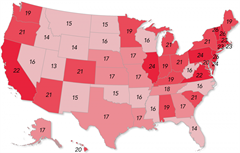Students and families across the country continue to see tuition costs for postsecondary education rise, and institutions of postsecondary education are no longer serving students well. A recent
study by the Foundation for Research on Equal Opportunity, featured in
FORBES, noted how the
PROSPER Act and the
Tax Cuts and Jobs Act will bring necessary changes to the status quo on how tuition costs are passed along to students from all socio-economic backgrounds who wish to reap the benefits from a postsecondary education.
Here are three lessons from the report:
By Ames Brown — April 3, 2018
A time of soaring tuition
College tuition continues to soar to record highs, having grown 5% annually for the past ten years. Today a degree from a four-year public college costs approximately $65,000, and $150,000 at a private one, according to the Department of Education.
Just 21% of Americans believe that college is affordable, according to Gallup. That’s a serious threat to Americans’ economic welfare considering that 65% of all jobs in the U.S. economy can be expected to require some college or a degree by 2020, according to the Georgetown Public Policy Institute.
A college education is already a major economic differentiator: the median income of Americans who haven’t gone to college is $36,000, while that of those with a degree is approximately $60,000: 67% higher, according to the Bureau of Labor Statistics’ Current Population Survey. Yet 52% of employers report they’re unable to find the employees they need according to ManpowerGroup’s annual survey.
College isn’t for everyone, but it’s important that every American that wants to get a college education can afford to.
| Average Annual Cost Of a 4-Year Degree, In-State, At Public Institutions, 2015-16 (Thousands of Dollars Per Full-Time Academic Year of Tuition, Fees, Room, and Board) The cost of a public degree varies considerably between regions. While tuition continues to rise across the country, the average costs of obtaining a degree from a public institution in the Northeast, the West Coast, and parts of the Midwest and South can be twice as high as in other regions. Six states with some of the nation’s highest unemployment rates—Illinois, Kentucky, Michigan, Mississippi, Ohio, and Pennsylvania—also are among the most expensive in which to obtain degree from a public institution. Evidence suggests this trend is likely to expand: Louisiana, which has the sixth-highest unemployment in the country, has the fastest-growing charges for a public degree, increasing more than $1,200 per year and 29% in the last five years, accounting for inflation. (Sources: Digest of Education Statistics. Table 330.20. Washington, DC: National Center for Education Statistics.; Office of Occupational Statistics and Employment Projections. Local Area Unemployment Statistics. Washington, DC: U.S. Bureau of Labor Statistics, December 2017) |
Reducing taxpayer funding for colleges increases out-of-pocket spending by college students
Shifting the burden of paying for college from taxpayers onto low-income students—such as in the case of rising tuition—is a regressive and significantly adverse social outcome. It is regressive because these students have lower incomes than most taxpayers; and it is socially adverse because, for these students, college is highly unaffordable, especially in families with siblings wishing to attend college, or if students are guardians with childcare expenses.
Public college subsidies may constrain low-income Americans’ opportunities
Subsidizing colleges instead of college students holds lower-income Americans back from getting the college education that best suits them. Giving subsidies to colleges instead of to students does not seem to be the best way to expand educational opportunities and access.
While public college appropriations are likely to become subject to increased scrutiny, appropriations directly to students may increase. [In December], Rep. Virginia Foxx (R., N.C.), chairwoman of the House Education and Workforce Committee, introduced a landmark proposal to overhaul the way the federal government funds and oversees higher education. Among that legislation’s many reforms, it expands the Pell Grant program, which makes grants directly to students in financial need that they can spend at any accredited college.
Click here to read the full story.
To learn more about the PROSPER Act and all the ways it makes postsecondary education work for students again, click here.




